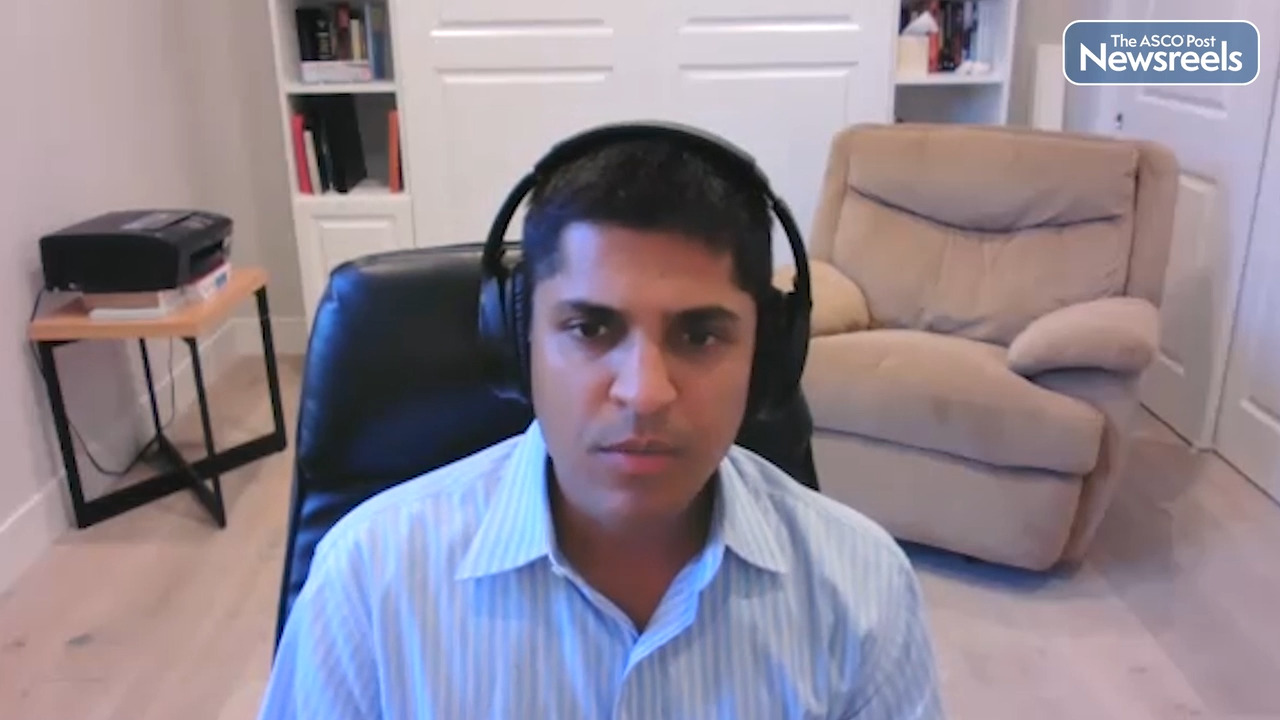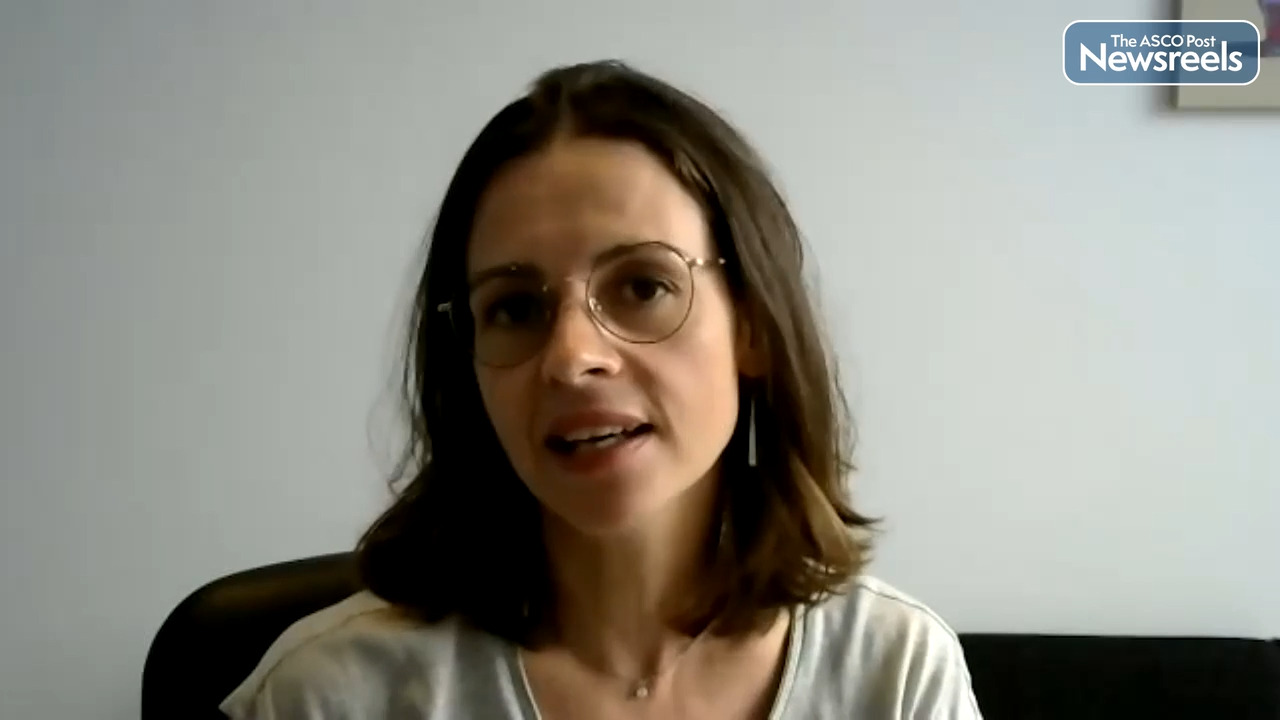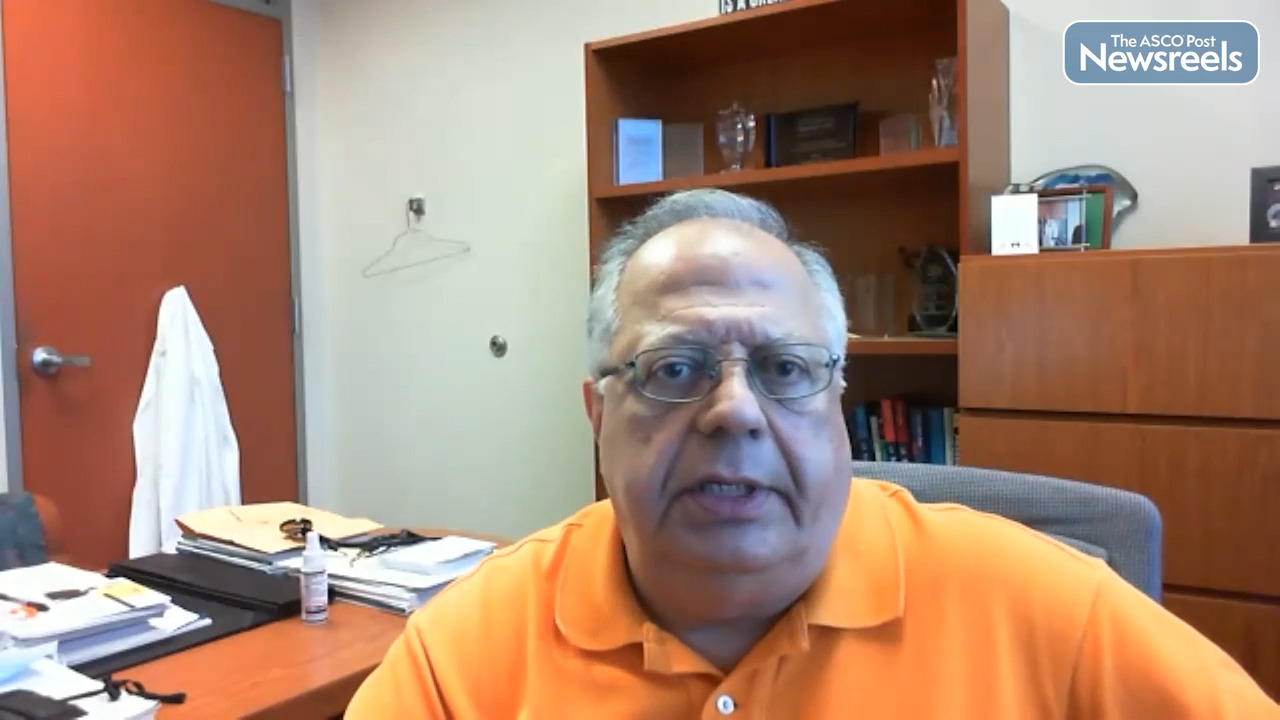Georgina V. Long, MD, PhD, on Melanoma: Findings on Circulating Tumor DNA, Disease Recurrence, and Immunotherapy
ESMO Congress 2022
Georgina V. Long, MD, PhD, of the Melanoma Institute Australia, discusses results from the CheckMate 915 trial, an analysis of the pretreatment circulating tumor DNA, along with other clinical and translational baseline factors, and their association with disease recurrence in patients with stage IIIB–D/IV melanoma treated with adjuvant immunotherapy (Abstract 788O).
Transcript
Disclaimer: This video transcript has not been proofread or edited and may contain errors.
Checkmate 915 was a trial that included patients with resected stage three B to stage four melanoma. In this trial 1,844 patients were randomized to either receive nivolumab, a standard adjuvant therapy or nivolumab combined with a low dose of ipilimumab every six weeks. The primary endpoint for this trial was the relapse free survival in the intent to treat population and a co-primary endpoint was the relapse free survival in patients with PDL one expression in their tumor, less than 1%. This trial was negative and has been previously presented and published. Despite being negative though, patients had plasma and tumor collected at baseline and furthermore plasma collected at week 13 and week 29. At ESMO 2022 I presented the results of the analysis of the circulating tumor DNA using these baseline bio specimens in all 1,127 patients were included, which represented 61% of the intent to treat population. These patients all had treatment and also had baseline tissue and plasma for analysis.
Using a patient specific, so using the patient's own tumor to identify what mutations were in their tumor and in their blood, we were able to create a patient specific panel to then detect circulating tumor DNA. We found that in the patient population where we looked at the circulating tumor DNA, the 1,127 patients, their baseline characteristics were exactly the same as that of the intent to treat population. The prevalence of circulating tumor DNA positivity in this population was 16%. We also saw that the prevalence of circulating tumor DNA was slightly higher in the higher sub stage of stage three, as well as those with a higher ECOG performance status. We did not see a higher prevalence of circulating tumor DNA in any other subgroup, including tumor mutation burden, positive or negative, patients with PDL one expression greater than or less than 1%, or BRAF mutation status although there was a slight trend to a higher circulating tumor DNA in that population.
We then analyzed the circulating tumor DNA and looked at the relapse free survival and distant metastasis free survival by the CT DNA positivity and found a very clear result with the Kaplan-Meier analysis that those with baseline positive circulating tumor DNA had a much poorer relapse free survival and a much poorer distant metastasis free survival. Importantly, the circulating tumor DNA positivity predicted early recurrence best with higher sensitivity and specificity at the early time points rather than at the later time points three months versus 24 months. Because this trial was negative, we did not see a difference in the treatment arms nivolumab versus nivolumab plus ipilimumab in terms of the circulating tumor DNA positivity and its prediction of relapse.
Lastly, we then combined the circulating tumor DNA with other tissue biomarkers, including the interferon gamma expression tumor mutation burden in the baseline tissue and found that by combining all three circulating tumor DNA and the interferon gamma and tumor mutation burden, we were much better able to predict recurrence. And had eight subgroups of patients with more accurate prediction of recurrence, the best performing group being the circulating tumor DNA negative interferon gamma baseline tissue expression high and high tumor mutation burden at baseline. Ongoing steps will be to come up with a composite biomarker analysis or predictive nomogram. And also we were looking at the circulating tumor DNA in longitudinal analysis from this trial to predict recurrence. I'd like to thank the patients and their families for their contribution to this trial.
The ASCO Post Staff
Marleen Kok, MD, PhD, of The Netherlands Cancer Institute in Amsterdam, discusses the initial results from the BELLINI trial, which tested whether short-term preoperative nivolumab, either as monotherapy or in combination with low-dose doxorubicin or novel immunotherapy combinations, can induce immune activation in patients with early-stage triple-negative breast cancer with tumor-infiltrating lymphocytes (Abstract LBA13).
The ASCO Post Staff
Rahul Aggarwal, MD, of the University of California, San Francisco, discusses recent data from the PRESTO study, which showed that apalutamide plus androgen-deprivation therapy (ADT) for 12 months significantly prolonged PSA progression-free survival compared with ADT alone in patients with biochemically recurrent prostate cancer. These results provide support for the intensification of ADT in this setting. (Abstract LBA63).
The ASCO Post Staff
Laurence Buisseret, MD, PhD, of Belgium’s Institut Jules Bordet, discusses phase II results from the SYNERGY trial, which tested first-line chemoimmunotherapy of durvalumab, paclitaxel, and carboplatin with or without the anti-CD73 antibody oleclumab in patients with advanced or metastatic triple-negative breast cancer. Although adding oleclumab to durvalumab with chemoimmunotherapy did not increase the clinical benefit rate at week 24, research is ongoing to better understand the mechanisms of response and resistance to this study combination (Abstract LBA17).
The ASCO Post Staff
Nizar M. Tannir, MD, of The University of Texas MD Anderson Cancer Center, discusses phase III findings from the PIVOT-09 study, which compared bempegaldesleukin plus nivolumab with the investigator’s choice of a tyrosine kinase inhibitor (either sunitinib or cabozantinib) in patients with previously untreated advanced renal cell carcinoma (Abstract LBA68).
The ASCO Post Staff
Antonio Marra, MD, of Memorial Sloan Kettering Cancer Center, discusses a mutational signature analysis that reveals patterns of genomic instability linked to resistance to endocrine therapy with or without CDK4/6 inhibition in patients with estrogen receptor–positive/HER2-negative metastatic breast cancer (Abstract 210O).





